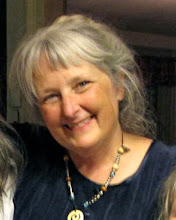Here's a letter I sent friends from
Vizag:
Roxanne and I are in Vizag now, going to pieces of the wedding almost every day and hanging out at the
school for developmentally disabled children the rest of the time. Another group of Americans is here, too, an advisory committee trying to help the school by giving a lot of advice and no money.
Vizag is very modern. So different from Benares and Bhubaneswar. Yesterday we went shopping for shoes to match my new saree for the main ceremony of the wedding, which is black and gold, very elegant (and only cost rs 1500). Driving through the shopping district with
Sarah we saw a rickshaw - and it looked totally out of place. In Benares, you're often riding in a rickshaw seeing nothing but other rickshaws, bicyclists, and cows being herded through the streets. We went to a meeting at Andhra University, which almost could have been an American university. There are new high-rises everywhere, the streets are wide and clean and cell phones are totally ubiquitous. People chat away in the holiest places. Roxanne tells them to talk somewhere else in their native tongue, which usually shuts them up fast.
India changes both faster and slower than the rest of the world. The saree, which is almost the only clothing women wear here in the south, hasn't changed much in thousands of years, the food, which is still eaten with the fingers all over India, is uninfluenced by outside cultures as far as I can tell. But technology! After dinner at
Devipuram, which is an ashram an hour and a half's drive from here, deep in the jungle, everyone watches TV after dinner. They have a satellite dish.
Guruji, after sitting in a hut giving out mantras to infertile couples while overseeing his students as they practice ancient rituals all day, logs on to his computer in the evening. He showed us his group's latest productions on the TV, too, a very sophisticated animation about the chakras. All this was true last time too, but now it's not new; it's just part of everyone's life.
It's been very enlightening observing the other Americans. They make almost no attempt to assimilate the culture. They wear their Western clothes, eat with forks and knives and ask that the food be modified to their taste - then they adapt it to make it fit their categories, eating the dal with a spoon and calling it "the soup" instead of pouring it onto their rice, sweetening and cutting fruit into their curd and calling it yogurt instead of salting it and mixing it with their other food, making jokes about "where's the steak?" When we went to the tailor's to have Roxanne's and my blouses made, they commented "some neighborhood!" when it was quite an ordinary street of small Indian businesses. One couple went to church on Sunday and another woman refused the chairman of the psychology department's invitation to dinner because she doesn't eat dinner after 7 PM.
At the conference yesterday we each had to speak briefly (embarrassing Indian custom, but part of the culture around guests). Roxanne spoke on cross-cultural communication, emphasizing the importance of being sensitive to the perspective of the other. I hope our American companions heard her, but I suspect they are already doing their best. After all, they are here, trying to help. What is painful to me is that the solutions they offer are so based in their own culture that all the people at the school are hearing is how inadequate their facilities and pedagogies are. All the American solutions are about getting more things, about doing more, and about cleanliness. The Americans don't see that their solutions either can't or won't happen here because the values are different and because time runs differently here. The children don't need the constant stimulation they are recommending: they need to know how to "be" and well as to "do", because in their lives, being is an important skill. The performance impressed that idea on us - the children sat perfectly still watching their compatriots dance, sing, play instruments for hours. American children could never have done it.

So much of this part of the trip has been about watching East and West interact, and I have to say, the Indian side comes off as gracious, generous, and accommodating, and the American as inflexible, limited by their own perception of what is right, and rude to the point of being racist. They treat the Indians like children. It's painful to see.
This morning we saw the groom
Srihari's feet painted and we took part in a blessing which involved putting rice and turmeric on his head! He's gentle and interesting young man, a drummer for the dance troupe his mother runs. After the ceremony his younger brother, who's the lead dancer, and his friend took us back to the school on their scooters. We took the road along
the bay, which is very beautiful, riding sidesaddle with our bags in our arms and our scarves flying out behind us.
Tomorrow evening is the main ceremony of the wedding.




















